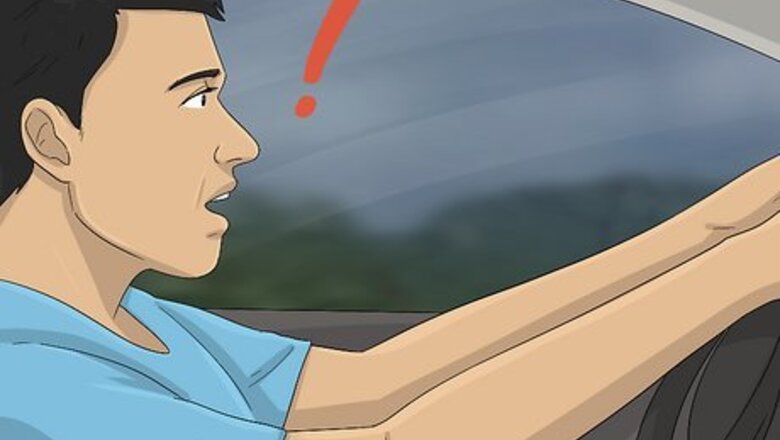
views
Assessing the Situation

Keep yourself safe. If you are in the middle of the road looking for the animal, you are in an area that is not safe. This is especially true if it's dark. Other vehicles may not see you and you can run the risk of getting hurt yourself. You should always be alert for other vehicles and assume they can't see you. Make sure you assess the condition of the road and listen out for oncoming cars. If it is a busy road, be extra careful. If you hit an animal on a busy highway, expressway, or interstate, you should not stop and try to help. The risk to your personal well being is too great.
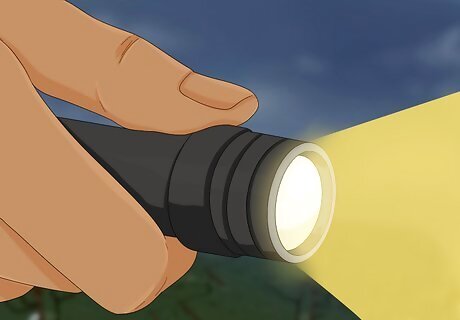
Use lights. If it's dark, you need to get a flashlight or other source of light. This will help you see where the animal is as well as help you be seen by others. You should also put on your vehicle's hazard warning lights to alert other drivers to your presence. Even if it happens during the day, put on your hazard warning lights to alert other drivers that you are stopped. It may be helpful to leave the headlights on if they illuminate the injured animal. If they don't, turn them off so as not to drain the battery in your car.
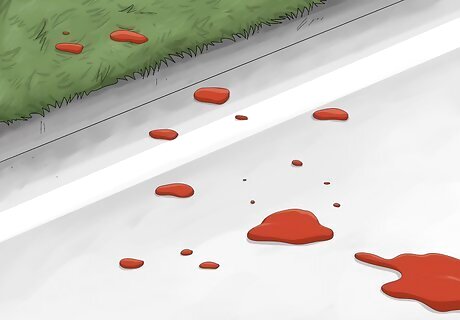
Locate the animal. In most cases, where the animal is will be obvious. The animal is usually still in the road or by the roadside. However, some creatures, especially wild animals, will use the last of their strength to run and hide. If you cannot see the creature, look for a trail of blood or recently flattened plants to see if you can spot him. If the animal is a wolf, large deer, or other dangerous animal, you should not approach without assistance.

Call for help if the animal is wild. It is possible that you hit a wild animal. Wild animals are likely to react with aggression at the best of times, but when injured they will be even more hostile. Before touching a wild animal, you need to prepare as fully as you can. If you have cell phone signal, call the nearest vet, the ASPCA, or a wildlife rehabilitator. You can find these numbers on the internet or by calling information. They may be able to send someone to help. If they agree to do this, stay with the animal so that you can guide the rescuer to his exact location. You should wait for their arrival if possible. The ASPCA or a wildlife rehabilitator will have special equipment for handling wild animals, such as leather gauntlets, special restraining devices, and cages. If you hit a wild animal that is considered dangerous or is too big, such as a wolf, fox, bear, or large deer, do not approach the animal. You should always wait for help with these animals because you do not want to get yourself hurt. Professionals know how to deal with these types of animals. Never deal with a hurt animal if emergency services are on the way. Just stay with the animal until they arrive.
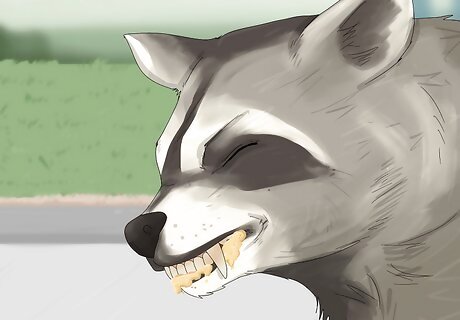
Never approach overly aggressive animals. If the animal you find is overly aggressive, you should no approach it, even if you cannot get help. If the animal looks like he is shaking uncontrollably, a dropped jaw, or excessive or frothy, white saliva, you should not approach the animal either. These are signs that the animal may have rabies. If you have no way to call for help when you hit this type of animal, you should take note of your location and then drive to a place where you can call for help.

Help the wild animal if no help is available. If the animal is wild but there is no animal inspector or veterinarian available, you need to plan how you are going to safely pick the animal up and transport it. If the animal is small, you need to look for a box or suitable container in your car to transport him. If he is large, you may need to fit him in the trunk. You may also need a large board or blanket so you can transport him. You should look for gloves or other protective gear as well. Having all of these things together will help you when you get ready to transport the animal. Do not pick him up before you make sure you are ready to handle him.
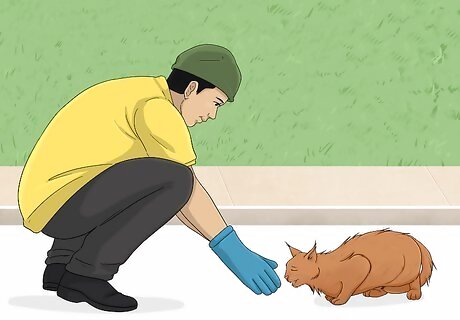
Rescue a domestic animal. Domestic animals are used to people and you may be able to approach and calm the animal much easier than a wild animal. However, you should be very careful in either case. Animals in pain will snap and react with aggression, so be prepared for this and act accordingly. You should follow the same size concerns as with a wild animal. Find a box or crate for a small animal. Look for a place to transport a large animal as well as a blanket or board. You should also find protective gear for domestic animals as well. They can be vicious, especially when injured. If the domestic animal allows you to approach it, fashion an improvised muzzle if possible. This will eliminate the risk of the animal biting.
Handling the Animal
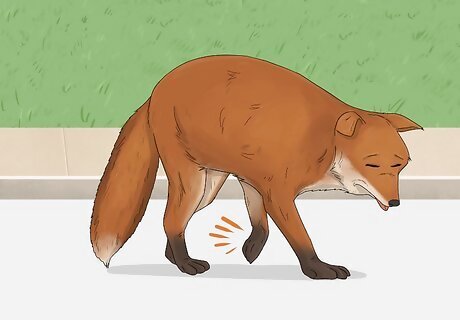
Assess the injuries. Before you touch the animal and try to move him, you should observe him from a distance. Look to see if the animal breathing normally. This means he is taking one breath every three to four seconds. Also notice if he is trying to get up and if so, watch to see if you can tell if his legs are damaged. If he doesn't try to get up, look for obvious injuries such as broken bones sticking through the skin, any excessive or noticeable bleeding, or the presence of gaping wounds.

Approach the animal. If you have decided that the animal needs immediate help and there is no emergency services on the way, you can approach the animal. As you approach the animal, you should move slowly and speak reassuringly to the animal. The animal will be scared and in pain, so calming tones will work best. Depending on the kind of animal or his size, you need to approach him in different ways. For a small, cat-sized animal, use a blanket or a coat to throw over the animal. This should prevent the cat or other small animal from turning and biting or lashing out with claws while you help him. You have a couple of different options for a dog. You should assume the dog will bite. You can throw the blanket over the dog's head, so his teeth are covered. What might work best, however, is to wrap a tie or a bandage around the dog's muzzle as a makeshift muzzle. Once the mouth is out of action, it is safer to examine the animal's injuries. No matter what method you use, make sure the animal can breath and you don't jostle him around too much. If you have to make a muzzle, make sure he has enough room left to pant and breath.
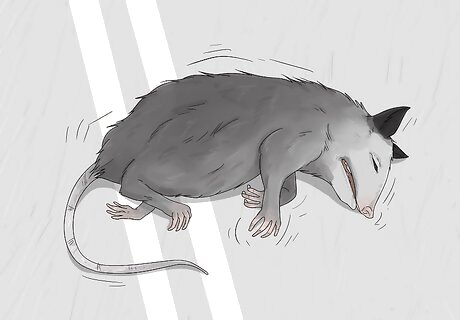
Look for signs of shock. The animal that you hit may go into shock. Animals can die from shock, even if they don't have physical injuries. Watch to see if he is panting, which is a sign of pain and shock. Other signs of shock include collapse, weakness, rapid breathing, pale gums, cold paws, slow capillary refill time, and lack of response to stimulus. If you see the animal in shock, you may need to help him on site before you take him to get help. Only do this is you feel it is necessary to save the animal's life.
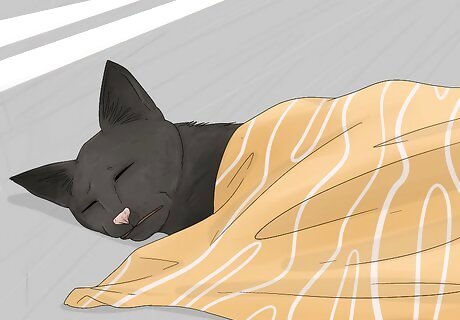
Cover him up. By the roadside, the amount of help you can give against shock is limited. In practical terms, the best you can do is keep the animal warm and get to professional help as soon as possible. Animals in shock have cold extremities because their circulation is struggling. If it is safe to touch the animal, you need to feel the temperature of the animal's paws. If they feel cool to the touch, he is suffering from chills and you need to wrap him up. For a domesticated animal with no obvious external injuries that need attention, cover the animal with a car rug, your coat, or a blanket. If the animal is small, wrap the coat right around the animal to insulate him from the ground. Never give pain relief medication to the dog. His body, especially in shock, will not absorb the medication and the drug will sit in his gut. This can cause serious gastric ulceration which could be life threatening further down the line. If the animal is bleeding or has an injury which need stabilizing, cover as much of the animal as you can. You should leave the bleeding area exposed for you to work on.

Care for a wild animal. If the wild animal seems dazed but has obvious external injuries, try to keep him warm while you wait for emergency services. Don't try to fix his wounds. If he is not recovering and remains dazed, his best chance of survival is being treated by a wildlife rehabilitation officer. If there is no help on the way, you need to transport the animal to the nearest facility. If the animal is merely winded, he may try to get up after a few minutes and wander off. Do not try to stop him. His best bet for survival is to stay on his territory in the wild. He has a den out there and knows where the resources are. Removing him unnecessarily could make it difficult for him to slot back in when released.
Dealing with Traumatic Injury
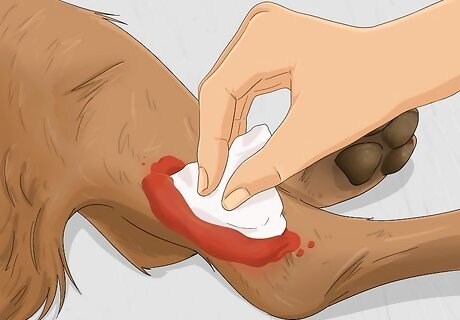
Stop the flow of heavy bleeding. Traumatic injuries cause two types of blood loss, heavy bleeding from severed arteries or veins and slow seepage from scrapes and wounds. The wound pumping blood should be given priority over the slowly seeping injury. If a wound is dripping blood, you need to try to stem the blood flow. First, apply pressure using a pad of cotton material applied directly over the area. Press down with sufficient pressure to prevent blood seeping through the cotton. If after 5 minutes you remove the pad and the blood starts pumping out again, repeat the pressure for another 5 minutes. Sometimes reapplying pressure is all it takes.

Apply a pressure bandage. If reapplying pressure doesn't work, you need to make a pressure bandage. A pressure bandage is another way of applying pressure and can be enough to stop the bleeding while you transport the animal. For a pressure bandage, make a cotton pad and hold it over the wound. Next, take a bandage or a cotton garment cut into strips and wind it around the area and the pad to hold it firmly in place. Apply firm tension onto the bandage as you wind it round so that finished dressing feels firm when you squeeze it. You should not be able to worm a finger between the bandage and the skin. These bandages can run the risk of impairing circulation to a limb if left in place for hours, but are acceptable if the animal may suffer potentially fatal blood loss otherwise. You should go directly to professional help after applying this type of bandage.

Make a tourniquet. If there is blood spurting out, the animal may have an arterial bleed. This is very serious and you may need to make a tourniquet. To apply a tourniquet, take a shoelace or tie and tie it around the limb so it lies between the bleed and the heart. Tighten the tourniquet until the bleeding stops. Be aware this has also cut off the blood supply to the rest of the limb so make haste to professional assistance. Only do this if it is essential and you suspect the animal may otherwise die from blood loss. Tourniquet use is controversial because there is a risk of the tourniquet cutting off the circulation, which potentially may cause the loss of the limb. You can reduce this risk by loosening the tourniquet every 10 minutes, which allows blood back into the rest of the limb. If you have someone with you, have her drive while you keep pressure applied to the tourniquet.
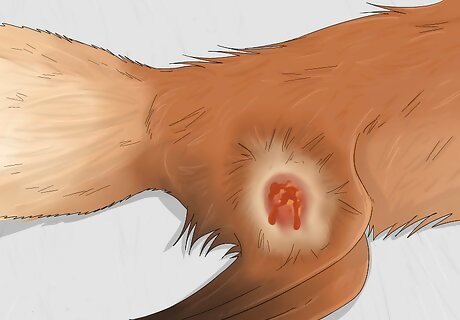
Dealing with slow seepage. A slowly seeping wound is an injury that is moist with blood but not actually dripping. In this case, it may not be necessary to do anything because this rate of blood loss is usually not dangerous. If necessary, collect a clean cotton cloth, such as a sterile swab from a first aid kit or a clean item of clothing. Form it into a pad and press it firmly over the area. Maintain pressure for 3-5 minutes and then remove the pad. The bleeding should have stopped. If it hasn't, either leave the wound and transport the animal to help or apply a pressure bandage over the area.
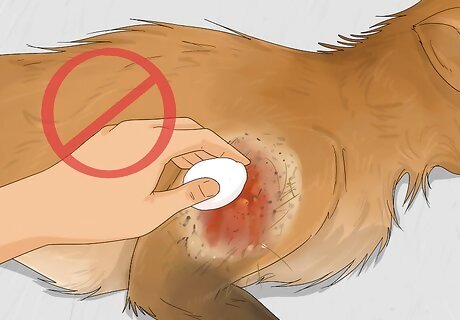
Do not clean wounds. When you working with the animal's wounds, do not try to clean them while you are still on the side of the road. Grit or contamination needs thorough irrigation with copious amount of sterile saline to be effective. This can only be done at a veterinary clinic or an equipped wildlife rescue area. You should not waste time after you access the bleeding and just get him to a clinic as soon as you can.
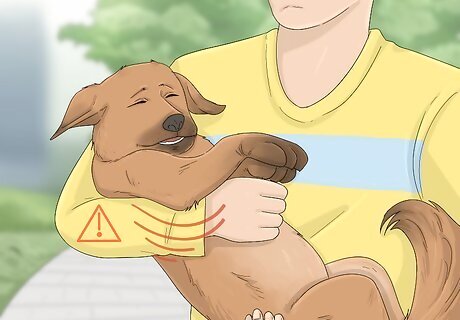
Support broken bones. If you notice or suspect that the animal is suffering from a broken bone, do not try to straighten broken limbs or push exposed bones back under the skin. You will cause unimaginable pain to the animal, which will worsen his shock and could kill him. If the limb is very floppy, gently support it by placing your hand beneath the limb to take its weight as you lift the animal. If bones are exposed and you have a first aid kit, lay a sterile swab over the exposed bone to try to decrease contamination. Lift the animal as you support the limb's weight and put the animal into your vehicle. You should not dress or bandage a limb by the roadside unless it is severely bleeding. The bandage can press on the broken bones and cause more pain. Just get to help as soon as you can.
Moving the Animal

Transport a small animal. If the small animal is already in a blanket, scoop him up while supporting the back and front end with your arms. If he isn't in a blanket or you need to move him to a cleaner or warmer material, you should lift the animal as gently as possible onto the blanket and then pick him up, supporting his back and head. You want to jostle him as little as possible because you don't want to cause any more pain. Never pick him up by the scruff and let the spine dangle perpendicular to the ground, especially if you think he has any bone injuries.
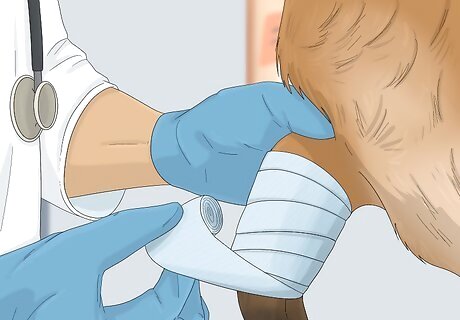
Carry a large animal. A large animal is much harder to move than a small one, especially if you are by yourself. A board or large, study object works best for carrying large animals. If you don't have one, a blanket or a coat will work. Lay the board or blanket behind the animal and lift him onto the board. Cover him with a blanket or towel and have someone help you carry him to your car. Do not roll the animal unless you absolutely have to. This can be extremely painful and cause more injury to the already wounded animal. If the animal struggles and kicks, you may need to secure the blanket down so they cannot injure themselves further by struggling. If you are alone, a blanket may be all that you can carry. Do the best you can in the situation that you are in and try to get to help as quickly as possible.
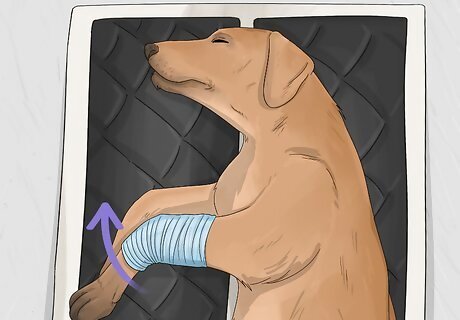
Be gentle. It will be necessary to transport the injured animal to veterinary care, and to do this he has to be moved. Your aim is to do this as gently as possible, so you do not worsen any injuries or cause unnecessary pain. If the animal has a broken bone, make sure the animal lies with the damaged leg on top so his body weight is not resting on the injured limb. If you suspect a spinal injury, handle the animal gently and try to support the back. You should also not move it too much or bend the back area. This can cause more injury and extreme pain.

Take the animal to help. Once you have the animal safely in your car, you need to take it to the nearest veterinary hospital or wildlife rescue. If you do not have a way to find out this information, you need to drive somewhere that you can find out this information and then find the nearest place for emergency animal care possible. If you are going to a vet's office, you should call ahead of time so they can expect your arrival. You should also call the wildlife rescue ahead of time and let them know the type of animal you are bringing in.




















Comments
0 comment